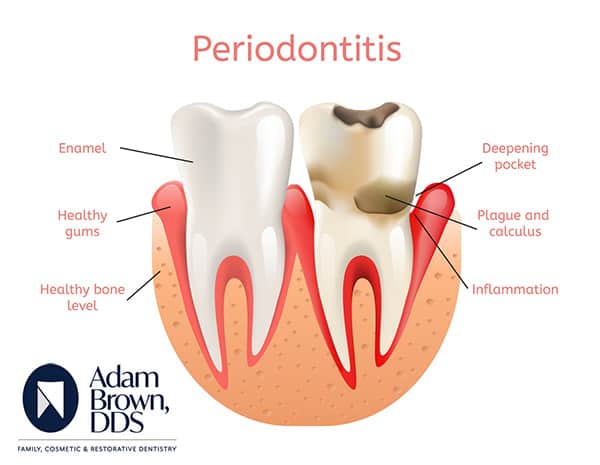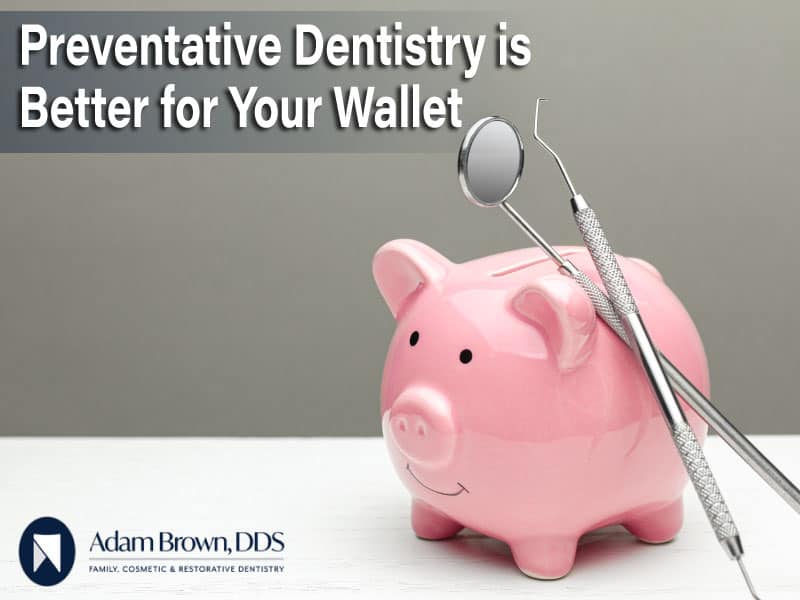Gingivitis vs. Periodontal Disease: What’s the Difference?
Gum disease can come in many forms, but most often it shows as gingivitis or — the more serious of the two — periodontal disease. Both can have serious side effects and happen to anyone; the good news is that gum disease is preventable. Knowing the differences between gingivitis and periodontal disease, paired with how to avoid them, will help you to maintain proper oral health.

To begin, it’s crucial to know the signs of gum disease. The typical signs of gingivitis are irritated, red gums that tend to bleed easily (even with the use of a soft-bristled toothbrush). Though gingivitis is a milder form of disease, if it isn’t treated correctly, it can lead to a more mature form of gum disease, periodontitis, which is flagged by inflammation and deep infection that eats away at the gums and teeth (the ligaments, sockets and all!).
The positive news is that both types of gum disease are treatable, even preventable, when you maintain proper hygienic procedures. If you’re experiencing sensitive and/or inflamed gums, your best bet is to come in for an examination right away. At Adam Brown DDS, we can accurately evaluate the health of your gums by taking measurements and x-rays of the jaw if needed. Once we make an assessment, we’ll develop a plan for treating and eliminating the disease through specific preventative methods.
 Signs of Gingivitis and Periodontal Disease
Signs of Gingivitis and Periodontal Disease
Unfortunately, noticing a white coloration on the gums or tongue, inflammation of the gums, light aches and pains inside the mouth, even chronic bad breath could mean a number of different things — and they all have varying levels of seriousness. That being said, as long as you catch the onset of gum disease in time and know the possible reasons, you can get your oral health right back where it needs to be. Here are a couple of specific gum diseases and their warning signs:
Gingivitis
This is a mild form of gum disease that is fairly common among American adults. If you notice your gums beginning to recede and turn white, gingivitis is most likely the culprit. A few other signs include swollen and bleeding gums, even painful irritation and loose teeth. The most common cause to gingivitis is poor oral care, so if you have fallen off the wagon a bit, it’s best to get right back into the routine of brushing and flossing regularly to avoid this uncomfortable situation.
Periodontal Disease
Periodontal disease is a more advanced gum disease that can quickly turn to periodontitis if untreated. Common symptoms if periodontal disease include:
- Gums that bleed when you brush your teeth or floss
- Bad breath
- Changes in the position of your teeth or loose teeth
- Receding gums
- Red, tender, or swollen gums
- Buildup of plaque or tartar on your teeth
- Pain when chewing
- Tooth loss
- Foul taste in your mouth
- Inflammatory response throughout your body
Symptoms in the early stages of periodontal disease (and periodontitis) are often not very noticeable. Your dentist will likely be the first to point them out.
How To Treat Gingivitis and Periodontal Disease?
As you can guess, the level of treatment depends solely on the level of progress the disease has made inside your mouth. Once properly cleaned by a professional and oral hygiene is maintained at home, early stages of either type of disease (gingivitis/periodontitis) begin to reverse and return to a healthy state immediately. However, if the gum disease has progressed, teeth may have to be removed and replaced.
When caught early, gum disease can usually be treated before tooth loss occurs. But preventing it altogether is even better than catching it early. Good and consistent at-home oral care (brushing and flossing) and regular dental checkups and cleanings can go a long way in keeping your gums healthy and disease-free. Some tips include:
1. Be Sure To Floss
Nasty rumors recently spread that flossing is bad for your teeth and gums. But any dentist will tell you this is simply not true, though flossing excessively can cause the gums to recede.
The key, and an important one at that, is to floss twice daily. Once in the morning and again at night. And the process should be as follows: rinse with mouthwash, floss, brush, and rinse again with water. Doing this twice a day will drastically help rid your mouth of unwanted residue from juicing or eating. How dare anyone say such a thing as flossing has unwarranted health benefits! It’s simply one of the most beneficial things you can do for your gums and teeth.
2. Get the Right Toothpaste
Many people like to rush right to whitening toothpastes. It makes sense, who doesn’t want white teeth? But when juicing, the acid that comes into contact with your teeth (and no matter what you do, there will be a least a tiny bit that does) makes them softer and more sensitive. Combines with the harsh chemicals in whitening toothpaste, this can cause a lot of discomfort.
It’s better to use toothpaste specifically made for sensitive teeth because it will clean the teeth well without hurting them. And, honestly, brushing twice a day will do well at keeping your teeth white. If you feel you need something more, there are plenty of products out there that do not hurt the teeth, even sensitive strips and mouthwashes that can advance your whitening.
3. Avoid Over-Brushing
Never thought you could brush too much, did you? Well, you can. Too much brushing can actually help the acid erode the enamel off your teeth. As previously said, juicing can leave your teeth extra sensitive. To go and brush excessively after that can cause some problems.
Try to stick to the twice-a-day standard, and use a soft or medium bristle when you brush. Brush lightly, and use a mechanical toothbrush if possible. These are made to get to those hard-to-reach places and they put the perfect amount of pressure on your teeth and gums. And nowadays, you don’t have to spend an arm and a leg to get one. There are plenty of reasonably priced electric toothbrushes out there; you just have to do a bit of research.
4. Chew Gum
Makes sense if you think about it. Chewing gum can break free those little seeds or bits of unblended food from your teeth. Just make sure you only chew sugarless gum. Otherwise, you will add to the harmful agents in your mouth. And it’s not a good idea to constantly chew gum. A few times a day, after meals is fine, but overdoing it can cause discomfort to sensitive teeth.
5. Use Mouthwash Regularly
Just like flossing and brushing, the twice-a-day rule is all you need with mouthwash. Use water if you feel the need to rinse more than that. But once in the morning, then again at night, can do wonders to clean the mouth. Mouthwash also helps keep your teeth white and your breath fresh.
6. Visit Your Dentist Twice a Year
This is one of the most important things to do. One visit to the dentist every six months is the perfect way to gauge how well your teeth are handling the juicing. A dentist can tell you if your teeth are becoming too sensitive or stained and advise you on what to do. It’s also good because you get a professional cleaning where someone is meticulously searching your mouth for cavities, bits of food, or anything else. Keep in mind that it doesn’t matter if you brush or floss first, as long as you consistently do a thorough job of both.
7. Drink Through Straws Whenever Possible
When drinking your favorite blended healthy concoction, it’s possible to keep most of the liquid from having too much contact with your teeth. This is especially true with thicker drinks. By using a straw, you can keep even more liquid from hitting your teeth.
It’s a good idea to have many different types of straws around, including a wide straw for thick juices, narrow or regular sized for normal densities, and a bendy straw just because they’re fun. Just stay away from those trendy metal straws because they can chip your teeth. Basically, any way of transferring your juice directly from the cup to your throat without touching anything (besides the straw) helps. Just be careful; using a straw makes drinking a lot of liquid much easier. You don’t want to overdo it on the juicing!
8. Always Have a Water Chaser
The more time acidic liquids have to rest in-between and on the teeth, the better the chances of stains and erosion. And you know what that means: more trips to the dentist and quite possibly some intensive dental work to be done.
So, even if you use a straw, consider keeping a glass of crisp and clean water to drink from between each gulp of juice you take. This makes those acidic bits even more difficult to stick around and manages to rinse any residue left behind that would stain the teeth. Plus, water will fill you up more, an added bonus for people who want to lose weight.
Conclusion
If you are experiencing any of the symptoms of gum disease, it’s essential to schedule an appointment with a dentist as soon as possible. Gum disease can be treated and prevented if caught early, so don’t wait until your gums start bleeding or your teeth start hurting. Adam Brown DDS is here to help you get your smile back on track — contact us today to schedule an appointment!

